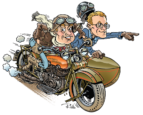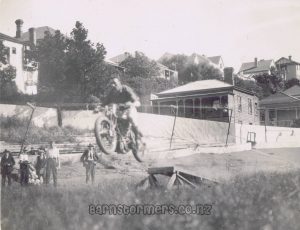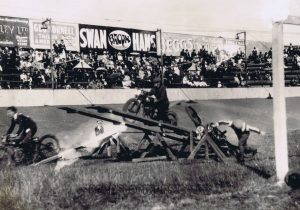Jumping motorcycles, or leaping over ramps and objects has been passion of many motorcyclists for years, so how far back does this sport go?
Overseas magazines always had pictures of riders performing acts of daring do. Leaping motorcycles over ramps, through rings of fire, and on high wire, all this in the 1920s. Well they were not alone because our history has recorded such events.
Palmerston North had their version of the Ben Hur race of chariots in the 1930s. Instead of horses pulling the chariots Harley Davidson motorcycles were used (if anybody has any original photographs of this event we would love to put them up on Barnstormers). Would have been exciting fun, just as well Health and Safety wasn’t around.
Beach racing was a major draw card for the public wanting to experience the excitement of motorcycling competition, but that required organised travel to the venue. Here was something completely new, and it was closer to home, at a local sports stadium. The game of football (soccer to us) would have enticed keen riders but what about the gymkana? How many riders would be willing to propel themselves off the end of ramps and seesaws for the enjoyment of the public. Remembering that some of these riders would be requiring their motorcycles to get to work next Monday. No doubt without thought of pain and suffering should something go wrong a few riders were keen. Limiting factors (besides the rider himself) would be the design of the motorcycle, they had no back suspension, and the rear wheels were quite lightweight in construction which could result in broken spokes and collapsed wheels. To lessen this risk machines were lightened as much as possible, including the removal of all unnecessary weight like steel mudguards, chain guards, lighting (if fitted) and then of course a very lightweight rider.
The following photos came from a well used but cherished album purchased from a second hand shop. Inside the front cover of the album was an inscription Xmas 1925 with a dedication to “Dear Elsie with love from Dorrie” so the album itself was obviously given as a Xmas gift and these photographs added later.
They were taken at was once the Auckland Sporting Ground which has been replaced by motorway on and off ramps in the Grafton Gully area of Auckland. This transpired in the mid 1960’s so this Ground has been gone for 50 years!
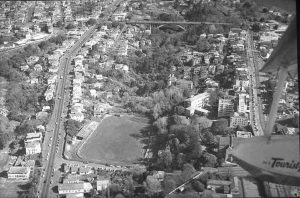
1950s Aerial shot of the now non existent Blandford Park
Blandford Park was in existence around the WW1 period and became the Auckland Football Association’s home when officially opened in 1925. There are two newspaper articles of the 8th and 10th January 1927 referring to a gymkhana staged by the Motorcycling Sports Club (later in 1932 to become the Auckland Motorcycle Club) at this venue. The event was organised by the Auckland Artillery Queen Carnival Committee.
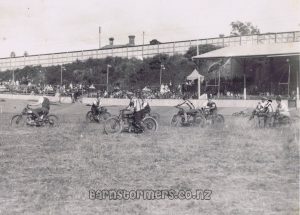
One of the events was an event of football played on motorcycles by two teams of five.
Then a Grand National Steeplechase was held with riders required to cross hurdles, traverse a see saw and a water jump. One photo shows the see saw and a rider falling off!
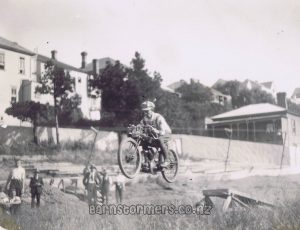
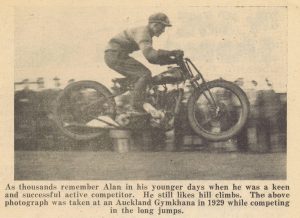
A young Alan McLaren competing at the hurdle at Blandford Park, and 2 years on still competing at a Auckland Gymkana
A detailed report on the Motor Gymkhana appeared in the 1927 January 10th edition of the Auckland Star.
Motor Gymkhana
Thrills at Blandford Park.
Fine Afternoons Sport
A large crowd attended Blandford Park on Saturday, when they were thrilled by the various events staged by the Auckland Sports Motor Cycle Club at the gymkhana held under the auspices of the Auckland Artillery Queen Carnival Committee.
First of all the spectators were treated to the intriguing novelty of football played on motorcycles by teams five aside. The riders, clutching small handlebars, opened throttles wide and circled round and dashed across field in a diapason of sound, the roar from the open, elongated exhaust pipes resembling that of the crickle-crackle of countless machine guns. Spills and collisions were frequent, but nobody was injured. The reds won the first game, beating the blue and whites by two goals to one. The game was played in two spells of five minutes each, the riders, instead of resting at the interval, giving a fine exhibition of acrobatic and trick riding.
The Grand National Steeplechase was easily the most exciting event of the afternoon. Riders were required to negotiate three flights of hurdles, a fairly high and difficult see-saw, and a water jump. The see-saw was a really difficult obstacle to surmount, and several riders came to grief.
Terra planing was most popular with the contestants, and also with the crowd. To terra plane you must first employ a heavyweight machine with a sidecar. On to this is tied a long length of stout rope. At the other end of the rope is a sled of wood, about three feet in length and two in width. On this the terra planer sits, gripping hold of the rope reins, and swinging and crouching from side to side as the motor cycle tears around the track. The winner of this event, J. H. Ratcliffe, gave a clever performance, making half-a-dozen circuits without losing his position.
The Auckland Artillery Band, under the baton of Lieutenant Colin Muston, was present, and dispensed a pleasing programe during the afternoon.
The Auckland Artillery Cup was presented to J. R. Bull, captain of the winning football team by the Artillery Queen (Miss Jean MacIndoe), who also presented the other winners with gold medals.
The results of the principal events were as follows –
FOOTBALL MATCH.
Final
Red (J.R. Bull, captain) . . . . . . . . . . . . . . . . . . . . . . . . 2 goals
Blue and Whites (J.H Ratcliffe, captain) . . . . . . . . . . 1 goal
RELAY RACE.
Final.
N.R Hunts team (Hunt, Butler, and Gordon) . . . . . . . 1
Goodwins team . . . . . . . . . . . . . . . . . . . . . . . . . . . . . . . . 2
TERRA PLANING.
J.H Ratcliffe . . . . . . . . . . . . . . . . . . . . . . . . . . . . . . . . . . 1
Millar . . . . . . . . . . . . . . . . . . . . . . . . . . . . . . . . . . . . . . . 2
LONG JUMP. (On Motor Cycles)
Fletcher . . . . . . . . . . . . . . . . . . . . . . . . . . . . . . . . . . . . . .1
R.M Moorcraft . . . . . . . . . . . . . . . . . . . . . . . . . . . . . . . .2
H Ratcliffe . . . . . . . . . . . . . . . . . . . . . . . . . . . . . . . . . . . 3
In an exhibition jump Moorcraft succeeded in jumping 32ft 5in – a better performance than that of the winners.
GRAND NATIONAL STEEPLECHASE.
R.M Moorcraft . . . . . . . . . . . . . . . . . . . . . . . . . . . . . . . .1
A Griffiths . . . . . . . . . . . . . . . . . . . . . . . . . . . . . . . . . . . .2
